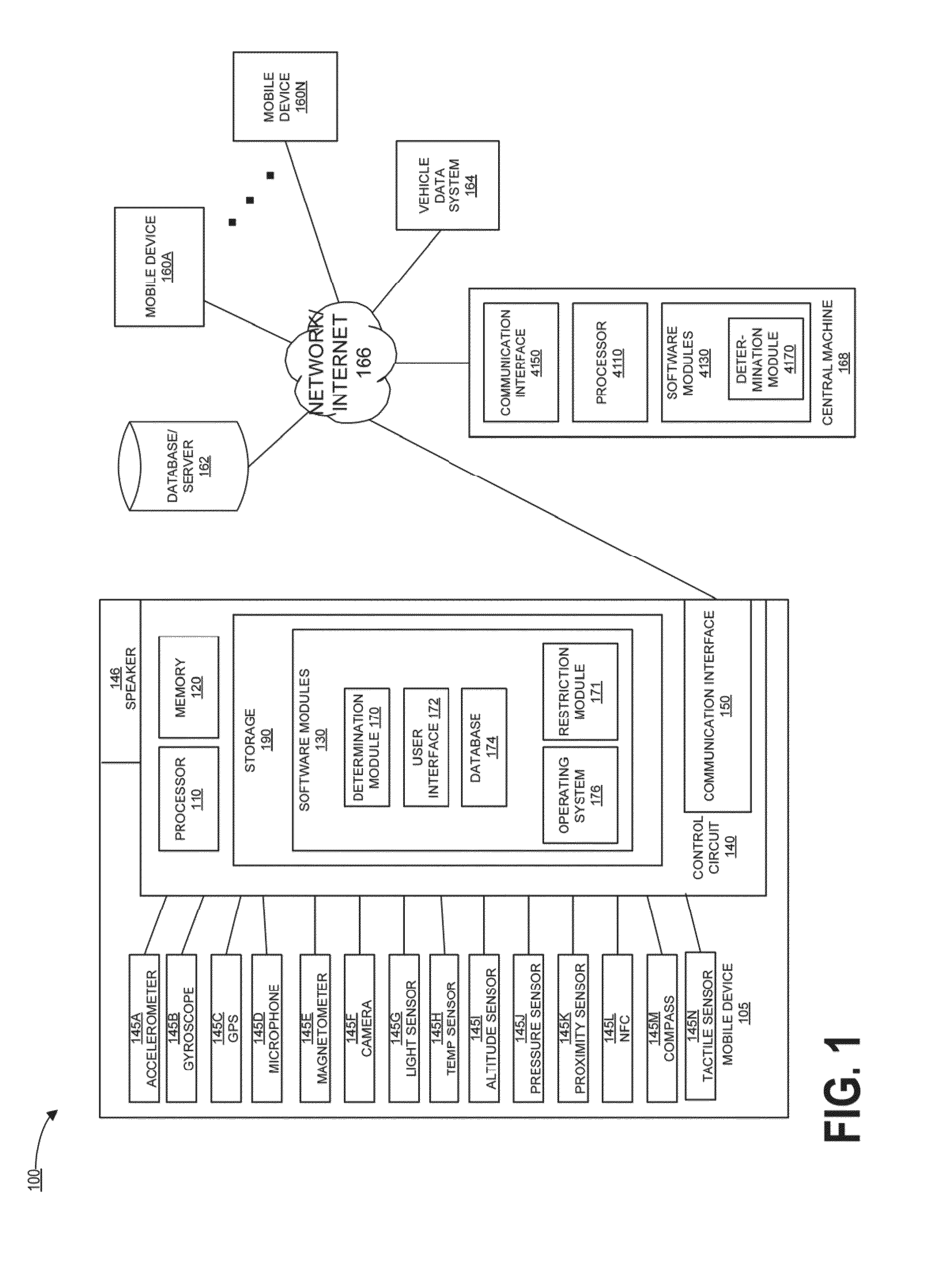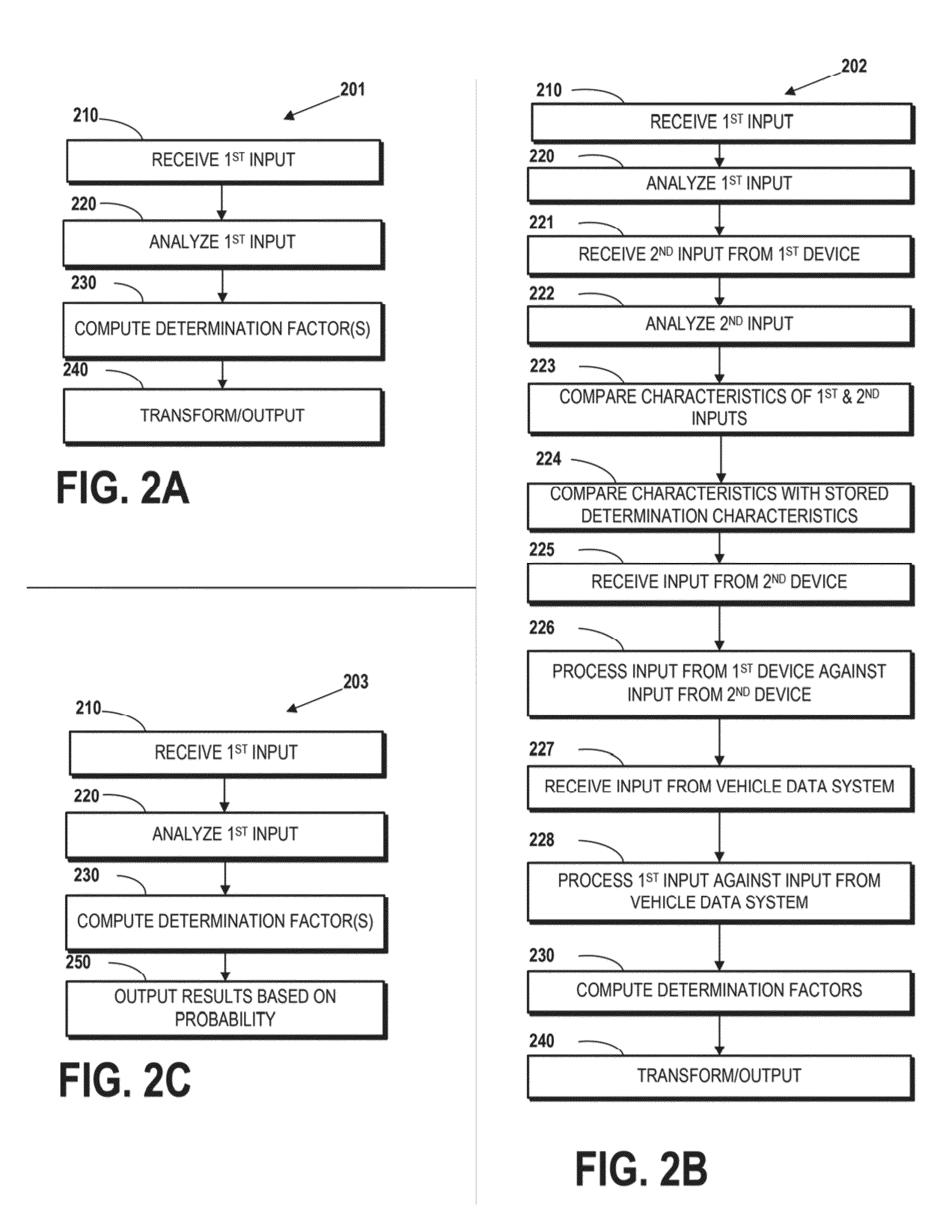Navigation instructions
a technology of navigation instructions and navigation devices, applied in navigation instruments, surveying and navigation, instruments, etc., can solve problems such as difficulty in effective police enforcement of such violations, poor enforcement effect of these laws alone, and increased crashes arising from cellular phone-based distractions
- Summary
- Abstract
- Description
- Claims
- Application Information
AI Technical Summary
Benefits of technology
Problems solved by technology
Method used
Image
Examples
example 1
[0460]There are a number of inputs that can be utilized in various arrangements in order to identify one or more user determination characteristics, such as the location of a mobile device 105 and / or if a mobile device 105 is being operated by the driver or by the passenger of a car / truck / bus, such as:
[0461]As also noted above, various arrangements preferably incorporate identification of one or more of the user determination characteristics referenced above and herein. In certain arrangements, each user determination characteristic (e.g. error proportion, correlation of typing speed to acceleration etc.) can be considered as a point in a K-dimensional space. Classification algorithms based on supervised learning, as are well known to those of ordinary skill in the art, can then be applied to the resulting K-dimensional signature(s) to determine the probability that the in-vehicle role of the user of mobile device 105 is a driver or a passenger.
[0462]Text Reading / Screen Viewing—User...
example 2
[0528]As noted above, such as at steps 222 and 223, considering multiple inputs can increase the accuracy of one or more of the determinations described herein, such as the determination of an in-vehicle role of a user of a mobile device 105, 160. This advantage is further illustrated above at steps 225 and 226, wherein inputs from multiple devices are considered in order to compute such determinations. Further illustrations of such inputs / determinations include, but are not limited to:
[0529]In-Vehicle Location—In the United States and in most other countries in the world, drivers are the left-front most occupant in a vehicle, relative to the front end of the vehicle. By identifying whether a particular mobile device 105, 160 is or is not the left-front most device within a vehicle, a determination can be made that such device 105, 160 is or is not being operated by the driver.
[0530]It should be understood that the referenced in-vehicle identification / determination is preferably ach...
example 3
[0534]As noted above, the processing of the various inputs discussed herein is preferably enhanced by incorporating various additional processing operations which serve to further enhance the accuracy of the determinations that are made. Examples of such further processing operations include, but are not limited to:
[0535]Clock synchronization—As noted above, in arrangements where inputs originating from multiple devices 105, 160 are processed together (such as several of those referenced above in EXAMPLE 2), it is preferable that simultaneous timing measurements originating at the respective devices 105, 160 are compared as well. In one arrangement, this can be effectively achieved by synchronizing the internal clocks of the respective devices 105, 160. By way of illustration, a relative displacement can be estimated, and this estimate can be used to process all relevant inputs such that they are synchronized to the same clock.
[0536]Examples of such synchronization methods include: ...
PUM
 Login to View More
Login to View More Abstract
Description
Claims
Application Information
 Login to View More
Login to View More - R&D
- Intellectual Property
- Life Sciences
- Materials
- Tech Scout
- Unparalleled Data Quality
- Higher Quality Content
- 60% Fewer Hallucinations
Browse by: Latest US Patents, China's latest patents, Technical Efficacy Thesaurus, Application Domain, Technology Topic, Popular Technical Reports.
© 2025 PatSnap. All rights reserved.Legal|Privacy policy|Modern Slavery Act Transparency Statement|Sitemap|About US| Contact US: help@patsnap.com



